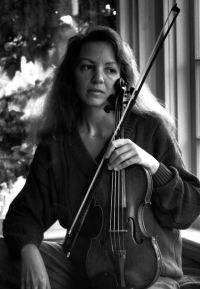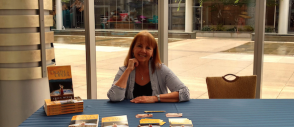MJ: Today's guest is a best selling author of romance, and she mixes in mystery, and her new novel has an historical setting that I particularly enjoy. Based
on a true story, Wild Rose Pass
is a romantic journey into yesteryear.
Katherine: Yes, what a storyteller. Karen Hulene Bartell, welcome!
Karen: Thank
you for inviting me to your blog! It’s a pleasure to chat with you
and Purrada!
Katherine: My dear pet Purrada has gone from stray cat to pampered cat. She has such a purrsonality, and I do enjoy her. I understand as an author that you have your own mews for muse - three rescued cats and a rescued "Cat"ahoula Leopard dog. Can you tell us a little about your critters, and have any appeared in your books?
 Karen: I
jokingly call our three rescued cats and rescued *CAT*ahoula Leopard
dog my “mews.”
The cats either lounge on my desk or my lap while I write, and the
dog sleeps beside my chair on his bed, so I’m surrounded by my
“muse.”
I wouldn’t say they inspire me, but they’re very empathetic and
are the models for critters in my book.
Karen: I
jokingly call our three rescued cats and rescued *CAT*ahoula Leopard
dog my “mews.”
The cats either lounge on my desk or my lap while I write, and the
dog sleeps beside my chair on his bed, so I’m surrounded by my
“muse.”
I wouldn’t say they inspire me, but they’re very empathetic and
are the models for critters in my book.
For
instance, Marmalade, our orange tabby stretched out on the desk,
purrs as I write. He was the stimulus for Earnestine, the six-toed descendant of the Hemingway cat in The
Keys: Voice of the Turtle,
that “communicated” with the heroine.
Our
*CAT*ahoula Leopard dog, Tory—short for Toreador because of his
brindle coloring—looks like he’s wearing Toreador pants and a
matching vest. He modeled for the puppy in Wild
Rose Pass.
MJ: In your newest release, Wild Rose Pass, oh what a rocky romance when two people of such different backgrounds are drawn to each other. This exciting book is set in the wild west of 1880's Texas. The setting is so vivid. How did you research this time period, and bring it to life?
Karen: Sixteen
years ago, my husband and I spent Christmas week hiking and horseback
riding in Big Bend National Park. You’ve seen the area on maps—the
southernmost tip of Texas that borders the Rio Grande and dips into
Mexico. Spanning more than 800,000 acres of Chihuahuan desert,
mountains, and rivers, Big Bend is larger than the state of Rhode
Island—and wild with lions and bobcats and bears. Oh, my!
Driving
home early that New Year’s morning, we missed the turnoff in Alpine
and followed TX-118 north. Snow-covered and glinting against the
frosty blue January sky, a remote jumble of mountain peaks and ranges
beckoned as they rose above the desert floor. I was enchanted. Gazing
at the sky island for the first time, wide-eyed, I wondered whether
those rocky pinnacles were mirages or optical delusions.
But
as the craggy peaks loomed larger (a mile high, I later learned), I
realized they were no hallucination or Fata
Morgana. A hasty
glance at the map told us these were the Davis Mountains. As we
approached, vertical basalt columns rose like thousands of giant
fingers reaching for the sky. The palisades, buttes, and bluffs
towered above both sides of Wild Rose Pass with a raw, majestic
beauty, and I breathed a contented sigh, sensing a homecoming. 

That
missed turn took us only a half hour out of our way, but as we drove
through Fort Davis and the Davis Mountains, it changed my life. From
that day to this, it’s held my heart and imagination, and I’ve
learned everything I can of its colorful history. Named after
Jefferson Davis, Fort Davis has seen Buffalo soldiers, Indian Wars,
Quanah Parker, cattle drives, Pancho Villa, and cinnabar mining.
When
I learned a friend’s great-great-grandfather had not only worked
for Fort Davis’ cavalry as an Indian scout in the 1870s and 1880s
but had been captured as a child and raised by Comanches, an idea
took root. The outcome of that budding thought bloomed into my latest
historical novel: Wild
Rose Pass, Book I of
the Trans-Pecos Series.
Katherine: As a best-selling author, you write multicultural, offbeat love stories steeped in the supernatural that lift the spirit. Your wonderful book The Keys: Voice of the Turtle has a fabulous blend of romance mixed into a murder mystery and includes two intriguing apparitions. Can you tell us a little about crafting this mystery plot?
Karen: The
Keys: Voice of the Turtle
is about something familiar to us all—moving forward, getting over
disappointments, even moving on. I started with a premise and the
characters’ missions. From that perspective, I expanded the scope,
dramatizing the story with ghosts passing over, widows remarrying,
and PTSD victims starting over.
A
probate battle over Keya’s turtle-nesting beach is the premise.
Land-hungry relatives want it bulldozed and developed, but she wants
it preserved as a turtle sanctuary. From there, a murder mystery
evolves with a calculating killer and a vengeful ghost. A second
apparition brings a 400-year-old mystery, along with buried treasure
also connected to the land.
For
me, travel sparks inspiration—and a visit to Key West and the keys
triggered this novel. Whenever I visit provocative places, encounter
new experiences, sample different ethnic foods, and chance upon
stimulating people, I’m inspired. Ideas flow. (I should’ve been a
travel correspondent.) There’s something about traveling that takes
me out of my rut and propels me into new realms of possibility.
I’ve
written some of my best concepts sitting in airports or hotel
bathrooms at midnight (so I don’t wake my husband with the light).
Being out
of my element and in
new environments stimulates my imagination. Traveling inspires me.
Each
of my novels takes place in a different setting because as I visit
those destinations, I’m infused with innovative ideas. I envision
scene after scene, like vignettes flowing into the next and the next.
So
what inspires me to write
The Keys: Voice of the Turtle?
Traveling to the unique keys with its distinctive ambiance. The
atmosphere set the tone. Then the characters emerged, and finally the
story unfolded.
Katherine: How important setting is in wonderful stories. Our mystery is set in Bayside, Washington. That's a completely fictional town near Seattle. The story and so many of the mystery's clues are greatly influenced by the sights in that part of the Pacific Northwest, Seattle's surprising history, and even the mystique of the area's weather including the secret that it doesn't always rain there. Bayside is such a contrast from Beverly Hills where my Katherine Watson's Designs company began and grew.
MJ: Karen, you lived an interesting childhood, and wrote your first book at nine years old. How did your childhood influence your interest in writing, or the books that you write?
Karen: I’ve
always had a creative imagination. (My childhood dolls were never
baby dolls—always lady dolls, who went on exciting adventures.) But
how did my childhood influence my interest in writing? In a word,
reading.
In second grade, my mother took me to the library and helped me
choose books. By third grade, I had my own library card, walked to
the library alone, and chose my own books. All during my childhood,
my mother let me stay up as late as I wanted—if I read. As a
result, I became a voracious reader, and in my case, writing was
simply a natural progression from reading.
Born
to rolling-stone parents who moved annually, I found my earliest
playmates as fictional friends in books. Paperbacks became my
portable pals. Ghost stories kept me up at night—reading
feverishly. The paranormal was my passion.
Wanderlust
inherent, I enjoyed traveling, although loathed changing schools.
Novels offered an imaginative escape. An only child, I began writing
my first novel at the age of nine, learning the joy of creating my
HEAs.
However,
I think everything we’ve ever read, seen, heard, and thought
mingles and merges in our brains as we sleep or meditate. When
inspired ideas crop up, I believe our minds recollect (re-collect)
that information and reassemble it into the prose we write.
Katherine: Do you have any sentimental, or otherwise favorite handbag or other kind of bag? We'd love to hear about it.
Karen: Sorry,
but I really don’t. I use the same black purse until it wears out,
and then I replace it with another almost exactly like it. I was once
given a citrus-green, alligator computer bag. I liked it, despite the
fact I was a vegetarian at the time, and nothing I owned matched it,
but it was, without a doubt, the most haute couture bag I’ve ever
owned.
Katherine: As an author, I can see how having a great bag for your laptop is a must. Your favorite bag reflects your passion. We're encouraging everyone to find out more about you, Karen and your wonderful books on your website karenhulenebartell.com. And who knows what your next trip will inspire!
 |
| That's meow for now, Purrada |











